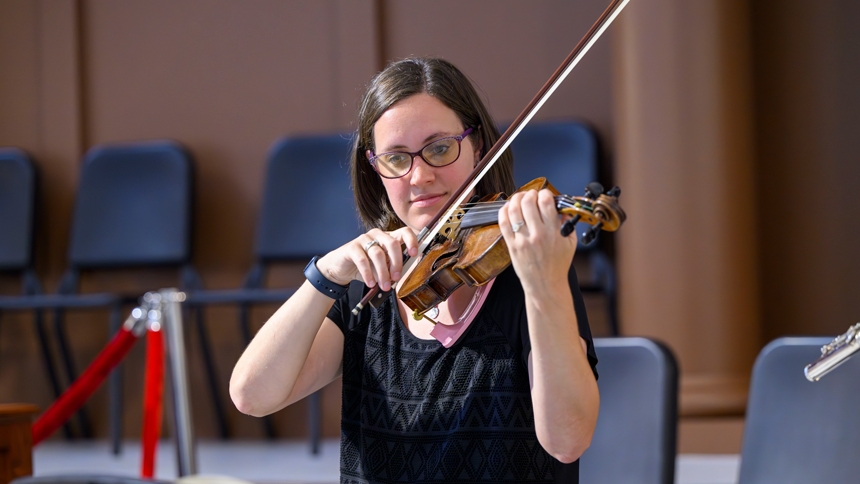
Photo by Greg Mintel
Unlike most of the mourners, Ashley Kovacs needed to get her tears out before the funeral. She wanted to pick up the violin that belonged to her friend, and play. She wanted to honor him. And the emotion was best directed into the strings.
For Kovacs, the road to that funeral for Monsignor Jeffrey Ingham, on Aug. 2, 2024, was long and meaningful.
The pair met more than ten years ago at St. Joseph Church in Raleigh. At the time she played violin there during Mass. They talked, and she discovered he was once a semi-professional violinist with the Fayetteville Symphony. She shared with him that she sometimes played with the NC Symphony. They discovered a mutual friend, fellow musician Paul Gorsky, and figured out that Monsignor had attended many concerts where Kovacs’ mother, Christine Ragonetti Martin, had played viola with the NC Symphony.
In 2015 Monsignor mentioned to Kovacs that he could no longer play his beloved violin because of arthritis. Also, the instrument was a little out of repair. He hoped she could help.
“I told him that I’d be happy to take it and get it fixed up,” she said. She took it for appraisal and new strings. She played it at Mass a time or two. A violin maker noted that although markings noted it was made in Florence, by De Vito Passaniti, it had some characteristics of a German instrument.
It seemed to be a bit of an enigma, Kovacs said.
Not sure of a musician who needed it, she gave it back to him for safe keeping.
“We had an understanding since we were both musicians and both loved the Lord and the Church; I really grew fond of him,” she said, noting that when she first met him she was a little intimidated because his reputation went before him.
He eventually moved from St. Joseph to St. Luke Church to serve, but she still ran into him sometimes at occasions such as weddings or other events.
“He would almost always mention his violin,” she smiled. “He’d ask, ‘Now do you know anyone who could use it?’ Or ‘What do you think I should do with it?’ And I would tell him, ‘Well, whatever you want to do really!’”
This year, on Palm Sunday, Kovacs took her violin to Mass to play. It was a heavy time in her life. She had lost her mother to cancer four months earlier. And she had heard of Monsignor’s recent cancer diagnosis. Privately, she offered the music for him.
A few months later, their mutual friend, Max Van Hecke, spoke with Kovacs. He had talked to Monsignor and Monsignor wondered if she’d take the violin.
“I said, ‘Of course!’ I arranged to meet him at St. Luke one morning. I did confession with Monsignor beforehand and after it was over he asked me in the confessional what I planned to do with it,” she said. “I said, ‘Well, my daughter is almost a full size and plays violin or I could use it to play for Mass or I could keep an eye out for a really gifted student.’ When he responded and said, ‘I’m going to completely leave that up to you,’ I about fell on the floor.”
Kovacs said she felt honored that he would trust her with his violin, which was so precious to him. That blessing, she added, made her want to “protect it even more.”
She also wanted to take a request. Kovacs asked what his favorite piece of music was and said she’d like to play it for him during Mass.
He said he needed time to think it over. In the meantime, Kovacs emailed Van Hecke about the matter, and suggested a piece called Nimrod, by Edward Elgar from his Enigma Variations.
“I had just played that for my mother the day before she had died and it’s a perfect one for pouring emotion into. Monsignor agreed about playing it. So I was planning to play it mid-August at Mass with Max.”
In late July, though, she learned Monsignor Ingham was close to death. She tried to arrange to play it for him where he was. By that time, though, he wasn’t taking visitors. He died July 29, 2024.
When she heard the news, she contacted David Danielson Eaton, director of music at Holy Name of Jesus Cathedral, where Monsignor’s funeral would be held.
“I reasoned that if I couldn’t play it for him while he was alive, I could at least offer it as a prayer for his beloved soul,” she said. “Praise God that it worked out that I could. It was especially meaningful and emotional for me to play his violin for the funeral because … Nimrod is such a heart wrenchingly beautiful piece. It was written [around 1898] by Elgar for a friend he had lost and treasured … I thought it would be perfect. I was also hoping that because it has such an emotional journey in the work that me playing it could help people access their own emotions and therefore healing in coping with his loss.”
Kovacs played. From the cathedral’s choir loft, she played and thought not only of Monsignor Ingham and those missing him, but of her own mother. [Listen on YouTube]
“My mom had given me the gift of music and she knew Monsignor,” Kovacs smiled. “There was a lot of emotion … what moved me during the Mass when thinking about Monsignor was not only the incredibly humbling gift of his violin but in thinking about how he had given me an even better gift. He had baptized two of my children. Not to mention the gift of the Eucharist on all those Sundays!”

